Other names Dragon Well tea | ||
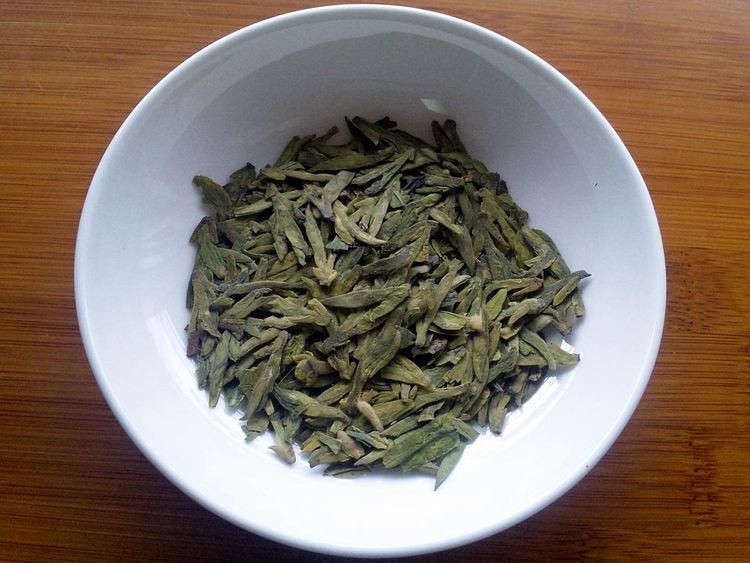 | ||
Quick description Very gentle and sweet, these teas can be quite expensive. The tea leaves can be eaten after infusion. Similar Green tea, Biluochun, Pu‑erh tea, Oolong, Fermented tea | ||
Longjing tea (simplified Chinese: 龙井茶; traditional Chinese: 龍井茶; pinyin: lóngjǐng chá; Cantonese Yale: lung4 jeng2 cha4; Standard Chinese pronunciation [lʊ̌ŋ.tɕìŋ.ʈʂʰǎ]), sometimes called by its literal translated name Dragon Well tea, is a variety of pan-roasted green tea from the area of Longjing Village near Hangzhou in Zhejiang Province, China. It is produced mostly by hand and renowned for its high quality, earning it the China Famous Tea title.
Contents
- How to steep longjing tea dragon well green tea in glass
- Production and health benefits
- Preparation
- Quality
- Legends
- Authentic Longjing
- Varieties
- References
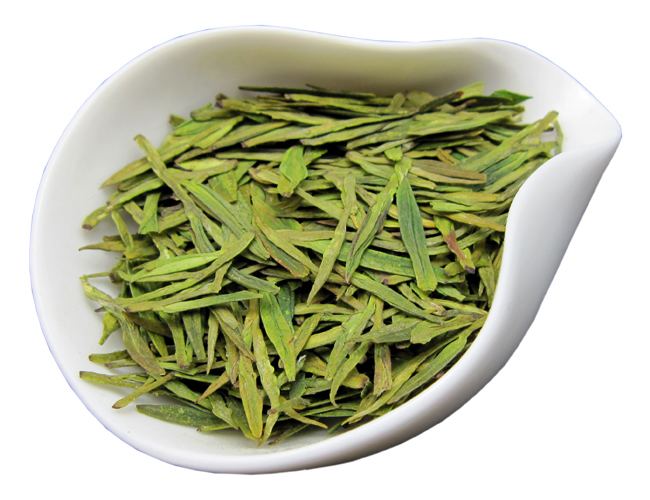
How to steep longjing tea dragon well green tea in glass
Production and health benefits
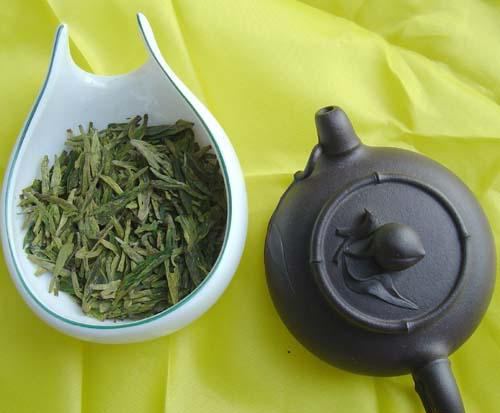
Like most other Chinese green tea, Longjing tea leaves are roasted early in processing (after picking) to stop the natural oxidation process, which is a part of creating black and oolong teas. The actions of these enzymes is stopped by "firing" (heating in pans) or by steaming the leaves before they completely dry out. As is the case with other green teas (and white teas), Longjing tea leaves experience minimal oxidation. When steeped, the tea produces a yellow-green color. The tea contains vitamin C, amino acids, and, like most finer Chinese green teas, has one of the highest concentrations of catechins among teas.
Preparation
For best infusion results, water at around 75-80 °C or 167-176 °F should be used to brew the tea leaves.
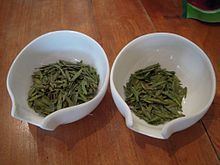
Although it is common practice nowadays to steep Longjing tea in porcelain or glassware, the real taste profile of a finer Longjing is achieved only by using a genuine, slightly porous, Yixing clay teapot, which since the beginning, was popular exactly for preparing green tea well.
Quality
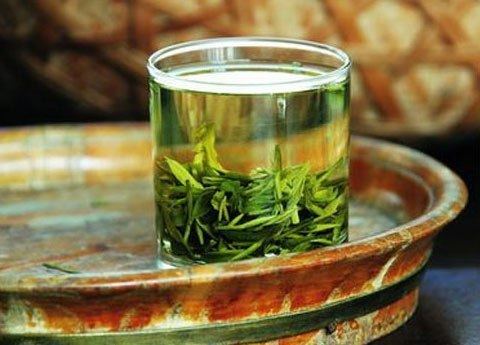
The tea can be very expensive, and the prices depend on the varieties, of which there are many. Longjing is divided into six grades: Superior and then 1 down to 5. Infused leaves are a good indicator of quality, which is characterized by maturity and uniformity of the shoots harvested for processing. High quality Longjing teas produce tender, whole leaves that are uniform in appearance. Lower quality varieties may vary in color from bluish to deep green after steeping. Before infusion, higher quality Longjing teas have a very tight, flat shape and light green color. A study by Wang and Ruan (2009) found that one aspect of the perceived low quality of Longjing teas was a higher concentration of chlorophyll, producing a darker green color. The study revealed that free amino acids and theanine concentrations contribute positively to what is perceived as a good taste.
Legends
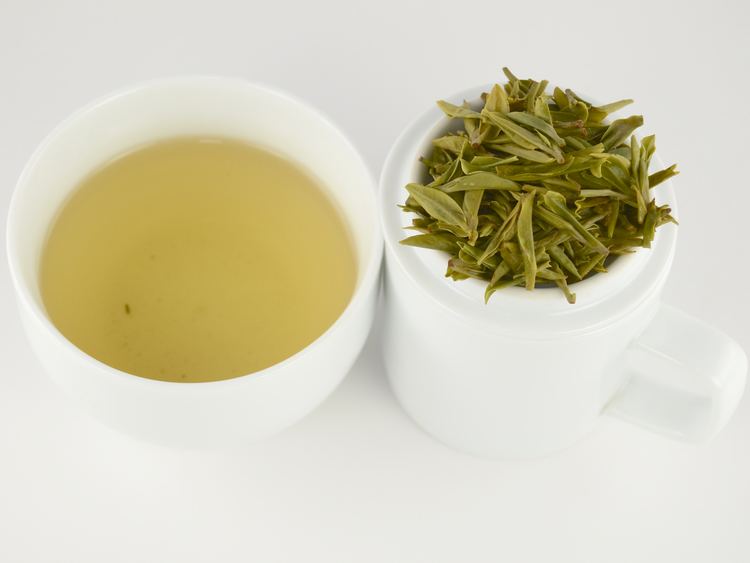
Longjing tea was granted the status of Gong Cha, or imperial tea, in the Qing dynasty by the Kangxi Emperor. According to the legend, The Kangxi Emperor's grandson, the Qianlong Emperor, visited West Lake during one of his famous holidays.
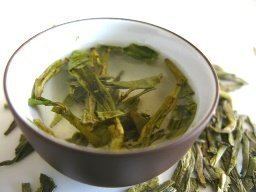
He went to the Hu Gong Temple under the Lion Peak Mountain (Shi Feng Shan) and was presented with a cup of Longjing tea. In front of the Hu Gong Temple were 18 tea bushes. The Qianlong Emperor was so impressed by the Longjing tea produced here that he conferred these 18 tea bushes special imperial status. The trees are still living and the tea they produce is auctioned annually for higher price per gram than gold. There is another legend connecting the Qianlong Emperor to Longjing tea. It is said that while visiting the temple he was watching the ladies picking the tea. He was so enamored with their movements that he decided to try it himself. While picking tea he received a message that his mother, Empress Dowager Chongqing, was ill and wished his immediate return to Beijing. He shoved the leaves he had picked into his sleeve and immediately left for Beijing. Upon his return he immediately went to visit his mother. She noticed the smell of the leaves coming from his sleeves and he immediately had it brewed for her. It is said that the shape of Longjing Tea was designed to mimic the appearance of the flattened leaves that the emperor brewed for his mother.
Longjing, which literally translates as "dragon well," is said to have named after a well that contains relatively dense water, and after rain the lighter rainwater floating on its surface sometimes exhibits a sinuous and twisting boundary with the well water, which is supposed to resemble the movement of a Chinese dragon.
Legend also has it that to achieve the best taste from Longjing, water from the Dreaming of the Tiger Spring, a famous spring in Hangzhou, is to be used. The water quality of the spring now is certainly very different than before. The tea takes its name from the eponymous "Dragon Well" located near Longjing village.
Authentic Longjing
There are various definitions of Longjing; however a common definition is that authentic Longjing at least has to come from the Zhejiang province in China, with the most conservative definition restrict the type to the various villages and plantations in the West Lake area in Hangzhou. It can also be defined as any tea grown within the Xihu district. A large majority of Longjing tea on the market however is actually not from Hangzhou. Many of these inauthentic longjing teas are produced in provinces such as Yunnan, Guizhou, Sichuan, and Guangdong. However credible sellers may sometimes provide anti-fake labels or openly state that the tea is not from Zhejiang.
Experienced drinkers may be able to tell if Longjing is authentic by taste and smell. The aroma and flavors of the inauthentic Longjing teas are not as complex, or long-lasting as the authentic tea. These teas, although similar in appearance, are mild in flavor and aroma and do not have the long-lasting aftertaste of the original.
Some tea makers take fresh tea leaves produced in Yunnan, Guizhou and Sichuan provinces and process them using Longjing tea techniques; and some merchants mix a small amount of high-grade with low-grade tea, and sell it as expensive high-grade.
